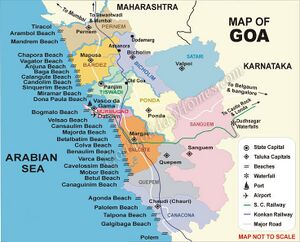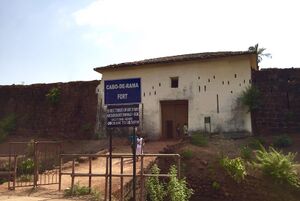Margao
| Author:Laxman Burdak, IFS (R) |

Margao (मड़गांव) is the commercial capital of the Indian state of Goa. It stands on banks of the Sal river and is the administrative headquarters of Salcete sub-district and South Goa district. It is Goa's second largest city by population after Vasco.
Various
- Mathagrama (मठग्राम)
- Maṭhagrāma (मठग्राम)
Location
Margao is located at 15°16′25″N 73°57′29″E. It has an average elevation of 10 m (33 ft). By road, Margao is located approximately 33 km from the capital Panjim, and 25 km from Goa international airport , 560 km South of Mumbai. Nestled on the banks of the Sal River, Portuguese style mansions dot its landscape. One of the fastest growing cities in Goa, its fast growing suburbs include Aquem, Fatorda, Gogol, Borda, Comba, Navelim and Davorlim.
Etymology
- Margão is the Portuguese spelling, with Madgao being used in Konkani. It was called Madgaon in Marathi. One theory holds that the name is derived from the Sanskrit मठग्राम (Maṭhagrāma) which means a village of monasteries.
- Another theory drawing from popular history suggests that is that the name in fact derives from its being the settlement of the caste of Mahars, hence Mahar gão (village of Mahars).[1]
History
In Ravanphond, now a suburb of Margao, there are shrines of Matsyendranath and Gorakhnath.[2] The abode of Nath medicants was called a Matha (Monastery). Madagao was called Mathagrama on account of Vaishnavite Math belonging to Dvaita sect which was founded in the latter 15th century and shifted to Partagal after the establishment of the Portuguese power.[3]
Margao in pre-Portuguese times was one of the important settlements in Salcete and known as Matha Grama (the village of Mathas) as it was a temple town with nine Mathas in temple schools. Its replacement in 1579 was destroyed by raiders. The present church was built in 1675.[4][5]
While the western side of the Holy Spirit Church developed as a market place, the settlement grew on the eastern side, that is, the Borda region.
Margao's importance as an administrative and commercial area grew with the increasing dependence of the surrounding towns and villages; leading to the administrative center with the town hall at its center being built in the south.
In 1961, Annexation of Goa led to its incorporation into the Republic of India, and Margao was declared as the administrative center of the district of South Goa.
Sal River
The Sal River is a small river in Salcete, Goa in India. The river opens near Verna and passes through the villages of Nuvem, Mongul, Seraulim, Colva, Margao, Benaulim, Navelim, Varca, Orlim, Carmona, Dramapur, Chinchinim, Assolna, Cavelossim, Mobor and drains itself into the Arabian Sea at Betul.
Cabo de Rama Beach & Fort

Cabo de Rama is a fort in Goa, India. Portuguese claimed the Cabo de Rama Fort after defeating the Raja (King) of Soonda and subsequently renovated it. In the past, the fort has switched hands between Hindu, Muslim monarchs and the Portuguese and had witnessed many battles in history. The present rickety structure with turrets and rusty cannons is a leftover of the Portuguese. The Portuguese equipped it with 21 guns and military barracks, as well as commandant quarters and a chapel. It was abandoned when the Portuguese left this place. Later, this fort housed a government prison till 1955 and was abandoned again. Today, this fort is in ruins, but is a popular tourist attraction of Goa.
मडगाँव परिचय
मडगाँव भारत के गोवा राज्य के दक्षिण गोवा ज़िले में स्थित एक नगर है। यह उस ज़िले का मुख्यालय भी है। पणजी के बाद यह राज्य का दूसरा सबसे बड़ा कस्बा है। यह गोवा की व्यापारिक राजधानी एवं सर्वाधिक व्यस्त कस्बा है। एक छोटी सी बस्ती है, जो एक किलोमीटर के दायरे में होते हुए बहुत ही आकर्षक जगह है। इस जगह से दक्षिण गोवा के कई महत्त्वपूर्ण समुद्र तट निकट हैं जिस वजह से यहाँ पर्यटकों की भारी आमद देखी जा सकती है। प्रसिद्ध चर्चों और मंदिरों के अलावा एक बात और है जो इस जगह को विशेष दर्जा देती है। ये जगह कई सारी संस्कृतियों को अपने में समेटे हुए है, यहाँ जहाँ एक तरफ चर्च और मंदिर हैं तो वहीँ दूसरी तरफ इस स्थान पर मुस्लिम समुदाय के लिए भी बहुत कुछ है। यहाँ पर कई सारी मस्जिदें हैं जिन्हें हर साल लाखों पर्यटक देखने आते हैं। यहाँ की मस्जिदों में शिया इमाम इस्माइली खोजा जमातखाना और अकुएम प्रमुख हैं । ये वो स्थान है जहाँ मुस्लिम समुदाय के लोग भारी संख्या में आते हैं। मडगांव,बेनौलिम कोल्वा, वर्का, बैतूल और मजोरदा जैसे मनमोहक बीचों से ज्यादा दूर नहीं है इस कारण, इन स्थानों से यहाँ आसानी से पहुंचा जा सकता है। यहाँ आकर पर्यटक बीच के आस पास से सस्ती दरों में बेहतरीन खरीदारी भी कर सकते हैं। अगर आप अच्छे खाने के शौक़ीन है तो यह जगह गोवा का दक्षिणी हिस्सा होने के कारण आपको एक उम्दा कुजीन प्रदान करती है। यहाँ आने वाले पर्यटक कई प्रमुख पांच सितारा होटलों जैसे ताज, लीला, हयात, और हॉलिडे इन जैसे होटलों में रुक सकते हैं जो प्रमुख स्थान से एक मील की दूरी पर हैं। अगर आपको एक छोटी सी राइड का मजा लेना है तो आप फिशरमैन व्हार्फ़ जरूर जाएं ये जगह बेतुल बीच के पास है । अगर आप गोवा आये हैं और आपको ताजा और प्रामाणिक सी फ़ूड खाना है तो आप मडगाव की यात्रा जरूर करें। मडगांव जाने के लिए डाबोलिम हवाई अड्डा सबसे बेहतर विकल्प है यहाँ से आपको प्राइवेट कैब आसानी से मिल जाएँगी जो काफी सस्ती होती है साथ ही यहाँ आने के लिए आपको वास्को दा गामा, डाबोलिम से ट्रेन भी मिल जायगी। यहाँ आने के लिए पर्यटक राजधानी पंजिम या वास्को डा गामा से ड्राइव करके भी यहाँ आ सकते हैं। [6]
कोलवा बीच
कोलवा बीच (Colva Beach): दक्षिणी गोवा के साल्सेट क्षेत्र में स्थित कोलवा बीच, गोवा के कुछ बेहद खूबसूरत समुद्र तटों में गिना जाता है। इसकी खूबी यह है कि उत्तरी गोवा के समुद्र तटों की तरह यहां भीड़-भाड़ नहीं होती और यह तट अपेक्षाकृत शांत रहता है। वैसे यह बीच गोवा के सबसे प्राचीनतम तटों में से एक होने के साथ-साथ यहां का सबसे लंबा समुद्री तट (25 कि.मी.) भी है। कुछ समय एकांत में बिताने के शौकीनों को यहां का शांत और खूबसूरत माहौल खासा लुभाता है। सफेद रेत के किनारे लगे नारियल के ऊंचे-ऊंचे पेड़ इस जगह की खूबसूरती में इजाफा कर देते हैं और सूर्यास्त के समय समुद्र किनारे टहलने के शानदार अनुभव को तो कभी भूला ही नहीं जा सकता। कोलवा से पर्यटक, ’काबो डि रामा’ (Cabo de Rama) किले तक आसानी से जा सकते हैं जो कि पूर्व पुर्तगाली समय का किला है और साथ ही गोवा का सबसे पुराना किला भी है।
कोलवा बीच का इतिहास: किसी जमाने में कोलवा एक विशाल बंजर इलाका हुआ करता था, जहां से अरब सागर का खूबसूरत नजारा दिखाई देता था। फिर मुग़ल और आदिल शाही राजवंश के शासकों को गोवा का उत्तरी और पहाड़ी हिस्सा इतना पसंद आया कि उन्होंने वहां के साथ-साथ यहां भी किलों और गढ़ों का निर्माण करवाया। लेकिन 1510 से 1961 के बीच यह इलाका पुर्तगालियों के कब्जे में रहा। तब इसे डॉक्टर डीओगो रोड्रिग्स की वंशज कहे जाने वाले रोईज़ नामक पुर्तगाली परिवार का गांव माना जाता था। उसे लोग कोलवा का भगवान मानते थे। कहा जाता है कि वह पहला शख्स था जिसने 1551 में यहां पहले पुर्तगाली वास्तुशैली से बने घरों का निर्माण कराया था। तब यह पूरा समुद्र तट भी उसी का हुआ करता तह और इसे प्राईआ दा कोलवा का नाम से जाना जाता था।
वाटर स्पोर्ट्स: यहां बनाना बोट और मोटर बोट की सवारी जैसे कुछ बेहद रोमांचकारी पानी के खेलों का लुत्फ़ तो उठाया जा ही सकता है, साथ ही समुद्र का यह हिस्सा तैराकी के लिए भी पूरी तरह सुरक्षित है। इसलिए यहां आने पर आपको तैरने के लिए सुरक्षित हिस्सों में लाल झंडे लगे दिख जायेंगे।
पाउडर जैसी सफेद रेत: यहां चारों ओर फैली सफेद रंग की पाउडर जैसी रेत विशेष रूप से लोगों को आकर्षित करती है और साथ में लगे नारियल के ऊंचे-ऊंचे पेड़ इस पूरे इलाके की सुंदरता को बढ़ा देते हैं। इस सबके अलावा यहां बने आकर्षक घर भी सैलानियों को अपनी साज-सज्जा की वजह से खासे प्रभावित करते हैं।
बेनौलिम समुद्र तट (Benaulim Beach): कोलवा से दक्षिण की तरफ करीब दो किमी आगे चलने पर स्थित बेनौलिम समुद्र तट पर बड़ी संख्या में स्थानीय लोग और पर्यटक घूमने आते हैं। हिन्दू पौराणिक कथाओं के अनुसार भगवान परशुराम द्वारा चलाया गया तीर इस जगह के समीप कोंकण क्षेत्र में आकर गिरा था।
संदर्भ: https://www.adotrip.com/hi/destination-detail/colva-beach
Gallery
-
गोआ का मानचित्र
External links
References
- ↑ Gracias, Radharao F. (23 February 2021). "Mahargao or Mathagram?". OHeraldo.
- ↑ Satoskar, B.D (1979). Gomantak: prakṛitī āṇi saṃskṛitī. Śubhdā-Sārasvat. p. 113.
- ↑ Mitragotri, Vithal Raghavendra (1999). A socio-cultural history of Goa from the Bhojas to the Vijayanagara. Institute Menezes Braganza. pp. 151–152.
- ↑ "Hindu temples and deities" by Rui Gomes Pereira
- ↑ "Gomantak Prakruti ani Sanskruti" by B.D.Satoskar
- ↑ https://hindi.nativeplanet.com/margao/#overview


